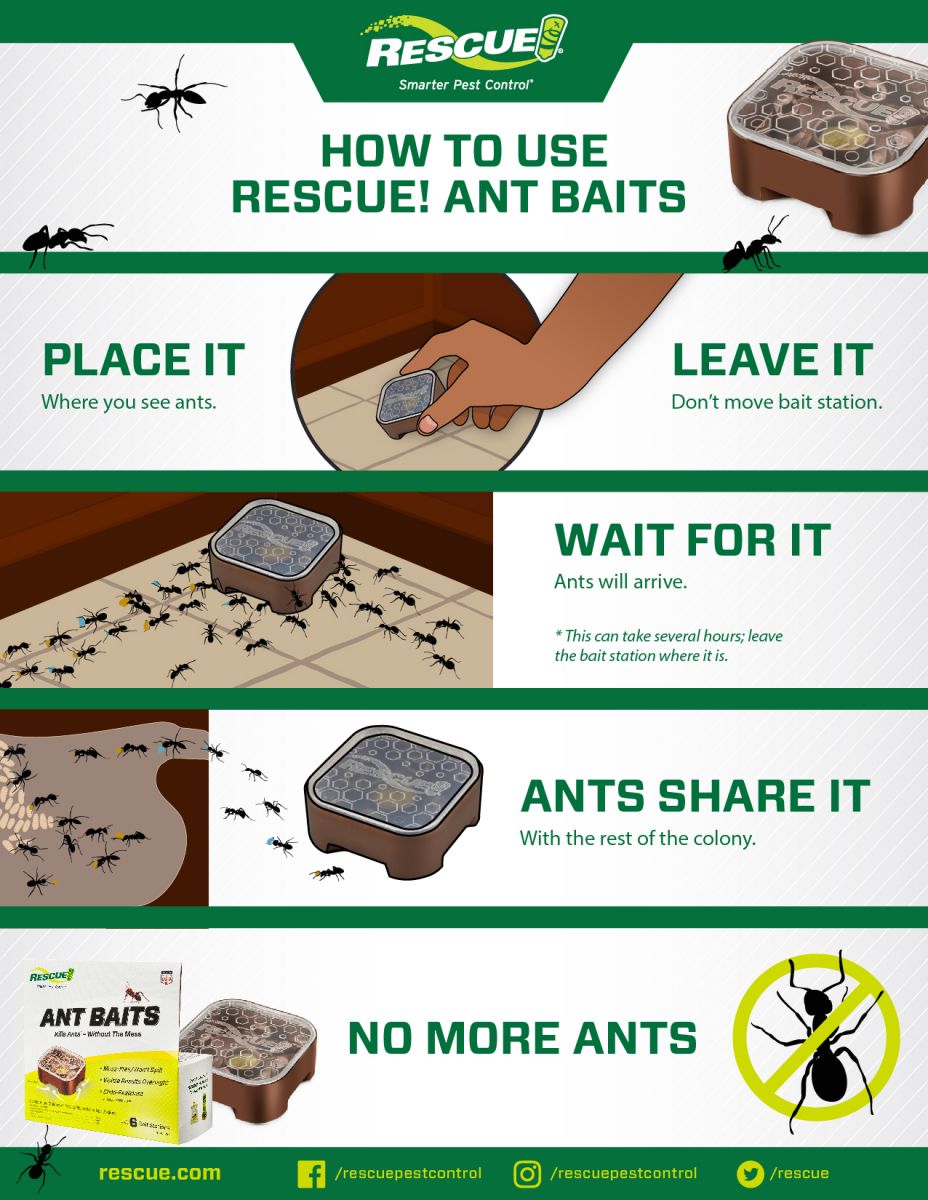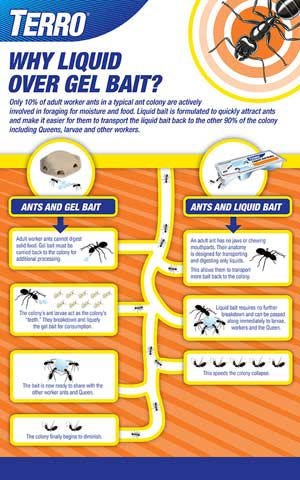You’ll know ant bait is working if you see a reduction in the number of ants over a few days. Witnessing ants carrying the bait back to their nest is also a good sign.
Dealing with an ant infestation can be frustrating. The effectiveness of ant bait often hinges upon identifying the ant species and selecting the appropriate bait. Once deployed, the bait serves as a trojan horse, carried into the colony by worker ants.
These diligent insects unknowingly ferry poison, masquerading as food, back to their comrades. Monitoring ant activity post-baiting is crucial for gauging success. A gradual decrease in visible ants indicates that the bait is doing its silent work. As ant populations begin to dwindle, it’s a clear signal that the bait has infiltrated the ranks and is disrupting the colony from within. Patience is key, as this process can take anywhere from a few days to a few weeks, depending on the bait’s formula and the ant colony’s size.

Credit: www.homepest.com
Identifying Ant Bait Success
When engaging in battle against a colony of ants, knowing whether the chosen ant bait is effective is crucial. This section will help you understand the signs that indicate your ant bait strategy is on the right track. Look for these clear indicators to assess the success of your ant control efforts.
Visible Reduction In Ant Activity
One of the most straightforward signs that your ant bait is working is a noticeable drop in ant numbers. Initially, you may observe an increase as ants are drawn to the bait. But, within days, a steady decline in their presence becomes evident. Keep a close eye on the previously high-traffic areas for these changes:
- Kitchen counters free of ant trails.
- Food storage areas with fewer ant sightings.
- Window sills and doorways no longer hosting ant parades.
These observed changes are a robust indicator that ants are consuming the bait and sharing it with the colony, leading to a reduced population.
Ants Carrying Bait To The Nest
Visual confirmation of ants transporting bait back to their nest is a positive sign. Ants operate on a ‘share and share alike’ system within their colonies. Therefore, spotting ants with bait in their possession is an indication of an effective baiting strategy. Key observations might include:
| Location | Observation |
|---|---|
| Ant trails | Ants with bait chunks en route to the nest. |
| Entry points | Ants disappearing into cracks with bait. |
| Nest sites | Increased activity as bait is distributed. |
These signs demonstrate not just consumption, but also the transfer of the bait’s active ingredients throughout the colony, ensuring a comprehensive reach of the ant control treatment.

Credit: www.rescue.com
Time Frame For Efficacy
Discovering effective ant control strategies is crucial for a pest-free environment. One vital aspect to consider is the ‘Time Frame for Efficacy’ of ant baits. Understanding how quickly you can expect results can significantly affect your pest management plan.
Initial Activity Increase
Ant bait might initially attract more ants. This can start within hours to days. It’s a good sign! The increase shows ants are taking the bait back to their colony. Here’s what to observe:
- Visible ant lines: Watch for a surge in ant traffic.
- More ants around bait: Seeing ants swarm the bait stations is expected.
Expected Results Timeline
The timeline for expected results from ant baiting is crucial. Mark these milestones:
| Timeline | Observations |
|---|---|
| 1-3 days: | Initial increase in ant activity. |
| 1-2 weeks: | Noticeable decrease in ant numbers. |
| Up to 4 weeks: | Significant reduction or total ant eradication. |
Patience is key. It takes time for ants to distribute the poison within their colony. Maintain bait availability and monitor the changes consistently. Trust the process for a gradual path to an ant-free area!
Assessing Bait Preference
Welcome to the insightful part of our post on ant control: Assessing Bait Preference. Knowing if ants favor the bait set out is crucial for effective eradication. This section will guide you through evaluating their preferences, improving your pest control efforts.
Monitoring Bait Attraction
Observe the bait location carefully. Are ants clustering around it? A successful bait will have ants swarming around it, indicating they are attracted to the bait you’ve placed.
- Count the ants approaching the bait within a set time frame.
- Record their arrival speed and numbers.
- Check back hourly to note changes.
Mark increases in ant activity as a positive sign. Your bait is enticing and potentially successful.
Switching Bait Types For Better Results
Not all baits suit every ant species. If the current bait isn’t attracting ants, consider switching it.
| Initial Bait Type | Observed Attraction | Next Steps |
|---|---|---|
| Protein-based | Low | Switch to sugar-based |
| Sugar-based | Low | Try grease-based |
| Grease-based | Low | Experiment with liquid baits |
Test different baits until you notice improved ant activity. A continuous assessment leads to selecting the most impactful bait.

Credit: www.terminix.com
Secondary Signs Of Bait Effectiveness
After setting out ant bait, you might ask, “Is it working?” Sure signs called ‘Secondary Signs of Bait Effectiveness’ give the answer. Not always quick, these signs are proof the plan is set in motion. Look for these tell-tale hints:
Decrease In New Ant Trails
Ants leave scent trails for others to follow. When bait starts working, you’ll see fewer new trails. Spotting fewer ants lined up means the bait’s doing its job. It’s not just about seeing less movement. Ants returning to the colony with bait slow new trail creation:
- Ants disoriented: No clear path to food reflects fewer ant paths.
- Scout ants not replaced: With fewer scouts, new trails drop.
Reduction In Nest Population Signs
Witnessing fewer ants around possible nest sites also signals bait impact. Bait carried back diminishes the colony. Signs the population is down include:
- Less activity: At openings, a clear decline means good news.
- Quiet nest zones: Usual busy spots going silent are promising.
| Effectiveness Sign | What to Look For |
|---|---|
| New Ant Trails | Fewer ants marching |
| Nest Population | Quieter, less busy areas |
Remember, patience is key. It takes time for bait to travel through the colony. Keeping an eye on these signs will offer assurance your efforts are paying off. Be consistent and continue monitoring for best results!
Troubleshooting Ineffective Bait
Setting ant bait can feel like a waiting game. Sometimes, it seems like nothing is happening. Ants may appear unfazed by the bait laid out for them, or worse, their numbers might even increase! Before you give up on your ant control efforts, let’s troubleshoot why the bait might not be grabbing those pesky ants’ attention.
Potential Reasons For Failure
Ant bait won’t work overnight. It needs time to lure the ants. To successfully troubleshoot, consider these common issues:
- The bait might be unappetizing to the ants because it’s stale or the wrong type
- Pesticide interference could repel ants from the bait
- Natural preferences may lead ants to other food sources
- Different species require specific bait formulations
- The bait placement might not be close enough to the colony
Understanding these factors will guide you towards a more effective baiting strategy.
Strategies For Enhancing Bait Attractiveness
After pinpointing potential reasons for failure, take these steps to make the bait irresistible:
- Refresh the bait regularly to maintain its potency and appeal
- Avoid using sprays or other deterrents near the bait to prevent repellency
- Observe the ants to determine their preferences and choose a bait type accordingly
- Identify the ant species and select a targeted bait that they can’t resist
- Place the bait in a path well-travelled by the ants ensuring easy access
By following these strategies and modifying them as needed, you’ll maximize the chances of bait success and start seeing fewer ants.
Frequently Asked Questions For How Do You Know If Ant Bait Is Working
How Long Does It Take For Ant Baits To Work?
Ant baits typically start to show effectiveness within 24 to 48 hours. Full control of the ant colony can take a few weeks.
How Do I Know If My Ant Poison Is Working?
To determine if your ant poison is effective, observe a reduction in ant activity and fewer live ants around bait stations within a couple of days. Dead ants near the bait also indicate success.
Does Ant Bait Attract More Ants?
Yes, ant bait is designed to attract ants with its appealing scent or taste, drawing them to the poison that will eventually eradicate the colony.
What Ant Bait Kills The Whole Colony?
Ant baits containing slow-acting insecticides, like borax or fipronil, effectively kill entire ant colonies. These agents allow worker ants to share the poison with the queen and nest mates.
Conclusion
Determining the efficacy of ant bait requires patience and observation. Signs of success include a noticeable decrease in ant activity and fewer sightings of trails. Remember, effective baiting can take several days. Stay vigilant and monitor progress for a pest-free environment.
Trust the process for best results.

I’m MD Tanvir, and I bring years of expertise gained from working closely with pest control companies to the forefront. My journey in the industry has inspired me to launch Bug Battler, a platform aimed at equipping people with the know-how to combat pests autonomously. Through Bug Battler, I aim to empower individuals with practical insights to tackle pest infestations effectively.

